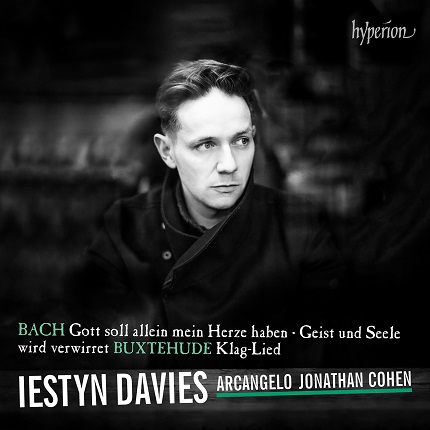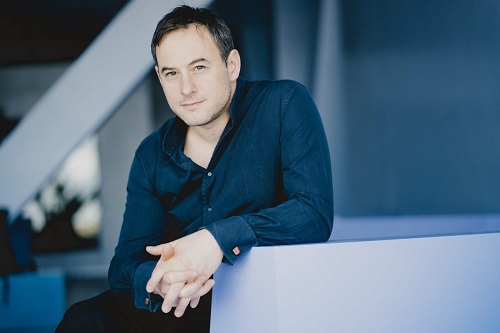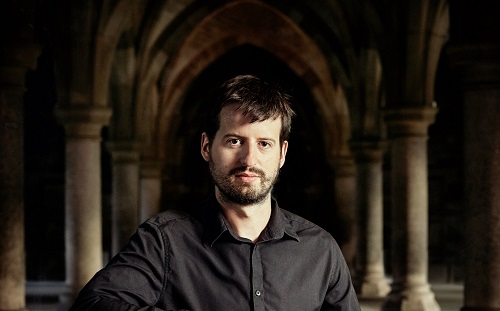In 2017, Iestyn Davies added an MBE, for his services to music, and a Gramophone Award, for his Hyperion recording with Jonahan Cohen and Arcangelo of three of Bach’s solo cantatas (BWV 54, 82 and 170), to his collection of awards and honours. With this new disc, released next month by Hyperion, the same musicians return to the year in which Bach composed the well-known Vergnügte Ruh’, beliebte Seelenlust (BWV 170) and present the two other cantatas for solo alto that Bach composed in 1726: Geist und seele wird verwirret (BWV 35), which was heard in Leipzig on the twelfth Sunday of Trinity, 8th September 1726, and Gott soll allein mein Herze haben (BWV 169), which was performed at the service on 20th October, the eighteenth Sunday of Trinity.
While the disc, which also includes music by Buxtehude and Schütz, naturally showcases Davies’s talent and artistry, the countertenor doesn’t have the spotlight entirely to himself. These cantatas date from Bach’s third annual cycle of church cantatas at Leipzig – cantatas which frequently feature a solo voice with a concluding chorale, perhaps expediently, given the challenge of acquiring sufficiently skilled singers and Bach’s own exhausting schedule, but are also characterised by substantial concerted solo parts for the organ, enhancing the instrumental invention and colour.

Such instrumental resourcefulness is immediately apparent in the Sinfonia which opens Gott soll allein mein Herze haben (God Along Shall Have My Heart, BWV 169). The movement is an arrangement of an older lost concerto movement and was later re-worked by Bach in the Harpsichord Concerto in E major BWV 1053. The soli first violins set the tone, issuing a fanfare-like invitation which the strings and oboes (three, including one taille or tenor oboe) accept with aplomb, vibrantly launching the exciting passagework which organist Tom Foster subsequently takes up, the notes spilling forth from the ‘Father Willis’ in St Jude-on-the-Hill, Hampstead Garden Suburb, with carefree charm, roving through daring modulatory sequences, dancing with refinement and purposefulness. The instrumental sound is quite reverberant, but the textures are lucid and the motivic interjections of the first violin and first oboe are crisply conversational. Artistic director and harpsichordist Jonathan Cohen makes the music sizzle as the streams of semiquavers surge with glorious abundance.
The cantata text is drawn from the gospel of Matthew and presents Jesus’s reply to the Pharisees when they ask him which is the most important commandment in the law of Moses: ‘Thou shalt love the Lord thy God with all thy heart, and with all thy soul, and with all thy mind’ and ‘Thou shalt love thy neighbour as thyself.’ The solo alto confirms the first of these laws in the opening vocal movement in which the certainty that ‘God alone shall have my heart’ repeatedly propels the recitative into a shapely arioso, as if the joy is so great that song cannot be suppressed. The unwavering focus and purity of Davies’s countertenor, as he shapes the phrases with innate artistry, is quite simply a wonder and a joy. There’s a guileless sincerity about the vocal expression, an easeful calm and freedom as the line climbs high – “Ich find in ihm das höchste Gut” (I find my greatest joy in him) – an artless grace as God’s blessings flow through the world, the soothing nourishment that they bestow evident in the exquisite trill with which Davies enriches the closing restatement of devotion. Such sentiments are reiterated in the following aria in which Foster’s florid yet delicate cascades between the vocal phrases are truly refreshing, an embodiment perhaps of the ‘stream of happiness’ that ‘trickles from the Hills of Plenty’ (“Ein Bächlein zu der Zufriedenheit/ Das von des Höchsten Güte quillet”) and that, glorified in the recitative, now inspires extended vocal phrases that Davies decorates with taste and discernment in the da capo.
The second aria, ‘Stirb in mir’ (Die within me), yearns to banish all earthly pleasures and desires, the sinfulness of which Bach depicts with astonishing harmonic capriciousness and a vocal line which meanders with treacherous unpredictability. Davies negotiates the precarious path with unwavering precision and surety, the sinewy undulations sweetened with lyricism. The low pitch (A = 415Hz) pushes his countertenor down deep at times, but there’s never any ‘break’ or loss of evenness. The darkness is apt, too – the voice sinks at the close, slipping away into the shadows – and complemented by the strings’ ceaseless siciliano inflections which Cohen shapes with expressive urgency. In the four-part chorale, ‘Du suße Liebe’, Davies is joined by Carolyn Sampson, John Mark Ainsley and Neal Davies, and the quartet conclude the cantata with an earnest prayer for God’s grace and love.
Throughout the 17th century German composers had been increasingly exposed to foreign musical influences, and it was their ability to uphold their own musical heritage while absorbing French and Italian elements that the Bach cantata with its integration of Italianate arias, Teutonic chorales and majestic polyphony, indirectly celebrates. So, it is fitting that Davies and Cohen choose to separate the two Bach cantatas with works by those who preceded him, Heinrich Schütz (1585-1672) and Dietrich Buxtehude (1637-1714). Schütz’s career was largely based at the Dresden court, but he had studied in his youth with Giovanni Gabrieli in Venice, and during a second visit to the Italian city, when he was in his forties, he sought out Monteverdi. Schütz’s vocal works are notable for their vivid, dramatic expression of their sacred texts, so his setting of the chorale ‘Erbarm dich mein, o Herre Gott’, with its strict observance of polyphonic methods, is quite unusual in his oeuvre, although the treatment of the chorale melody is characteristically adventurous.

Here, the low register of the string introduction establishes a sombre mood, and there’s a plangent resonance to the timbre, though Cohen doesn’t allow the pulse to sink into melancholic inertia. Indeed, when the voice enters there’s an almost fearful urgency about the increasingly pressing repetitions, “Erbarm dich” (Have mercy), the minor third that ‘traps’ the voice seeming to embody the sin and wickedness from which the penitent begs release. Davies uses vocal colour to evoke contrition, anguish, reverence and hope – sometimes all within the same vocal phrase, as when the initial pleading rises to a pure appeal to ‘o Herre Gott’. The sense of man’s vulnerability before God is tempered by a candour which is deeply touching, as in the descending simplicity of the acknowledgement of sin, “Ich erkenn mein’ Sünd und ist mir leid”. Cohen shapes the imitative writing expressively, the first violin’s echoing of the vocal implorations enhancing the beseeching quality of the motet. Even in this darkness, Davies and Cohen find drama.
Buxtehude, whom both Bach and Handel are known to have visited in Lübeck, is represented by a strophic song, which forms a sort of appendix to Buxtehude’s cantata, Fried und Freudenreiche Hinfarth. The elegy (Klag-Lied) ‘Muß der Tod denn auch entbinden’ was written upon the death of the composer’s father in 1647. This absorbing lament pushes the voice high and low, and Davies negotiates the troughs and peaks consummately. He and Cohen never let the melody become indulgently languorous; each verse has fresh colours, and new textual inferences. Originally, bass viols would have accompanied the elegy: here we have the soft-grained viola da gambas of Kinga Gáborjáni and Reiko Ichise, and some sensitive interjections from theorbist Sergio Bucheli. The music is doleful, the pulsing accompaniment sometimes pained, but there is again a dramatic heartbeat that Davies exploits to the full.
Geist und seele wird verwirret (Spirit and soul become confused,BWV 35) has two Sinfonias, as the cantata was performed in two parts, either side of the communion service. These instrumental movements are thought to be adaptations of earlier music – the Klavier Concerto BWV 1059 and a now lost oboe concerto of Bach’s Cothen years have been proposed as possible sources. Certainly, the concertante style of the first Sinfonia is strikingly gallant and Italianate, with its bright buoyancy, Vivaldian sequences and airy voicing. Foster’s organ is deliciously light and animated as it runs confidently through the counterpoint with a virtuosic spring in its step.
The string articulation is just right, crisp but with tonal focus, and the three oboes imbue the busy interplay of ritornelli and episodes with a comforting warmth. Cohen generates a bracing sweep as the motivic development unfolds uninhibitedly, the music, though urgent in tone, seeming to delight in its own invention. Foster’s elaborate excursions above bass pedals are fittingly bold in manner – the decorations of the rising chromatic steps near the close are almost brazen – and the whole D minor Sinfonia is so confidently vigorous that it can only end, as it does, with a cadential sigh of satisfaction in the tonic major. Cohen doesn’t push the Second Sinfonia perpetuum mobile too hard, and so the vivacity is elegant and energised rather than reckless – the music is certainly driven, just not dangerously so – but Foster’s flawless finger-work, audacious yet refined, still impresses!

Georg Christian Lehms’s text is based on the account in Mark’s gospel of Christ’s healing of a deaf-mute man, and expresses the confusion felt by those who witness God’s miracles and are themselves rendered speechless (“taub und stumm”). The organ part is no less assertive here, repeatedly breaking free from the instrumental siciliano – played with a stateliness which is kept in restraint by the short phrases. Foster takes flight in agile discursions and diversions, reflecting perhaps the agitation felt by the confused (“verwirret”) soul, and the organ even overspills the final instrumental cadence of the da capo repeat. Davies complements evenness of line, in defiance of the melodic angularity and chromatic contortions of Bach’s vocal writing, with expressive colour. The coloratura is made to seem effortless – what a lovely blossoming Davies crafts when reflecting with joy on God’s wonders, “Und das Volk mit Jauchzen nennet” – and brilliantly executed trills (“betracht’t”, “gemacht”) link the sight of God’s power with its effect on those who behold it.
Preceded by a recitative, the fluency of which conjures a growing understanding of that divine power – “Du öffnest auf ein Wort die blinden Augenlider/ Dies, dies sind Wunderwerke’ (With a word you open the eyelids of the blind. These, these are your miracles.”) – the second aria is a celebration of God’s love and care, for organ and voice alone. The steady step of Foster’s bass line conveys the reassurance that faith brings, while the right-hand rejoices vibrantly, with gleeful ‘string crossings’ expressing that uplifting certainty. The long elaborate vocal lines skip by with the nonchalant grace and ease of a virtuoso violinist, but Davies’s eye for musical detail misses no opportunity for drama or expressive heightening, the syncopated entry of the last heartening reiteration, “Gott hat alles wohlgemacht” (God has own all things well), being discerningly exploited to lift man’s spirit higher still.
After a short recitative, subtly accompanied by Foster, in which the believer’s heart is opened up to God, and his ear and tongue touched by the Lord so that he can perceive and praise God’s miracles, the final aria, ‘Ich wünsche nur bei Gott zu leben’ (I wish to live with God alone), brims with joy. The oboes inject a touch of trumpet-like nobility while the organ insists on enlivening the instrumental minuet with spinning triplets which propel the vocal line on elaborate flights. This is absolutely stunning singing: the wide tessitura, rapid vocal leaps, extended coloratura ‘breakouts’ – anticipating the “fröhliches Halleluja” – and stamina-stretching phrases pose no problem at all for Davies. Even the twisting harmonic trickery that conveys the sorrow and torment (“Das jammerreiche Schmerzensjoch”) that must be endured on earth before man can be united with God is insouciantly despatched. This is a performance that truly heartens and heals.
Released by Hyperion Records in February 2022.
Claire Seymour
Iestyn Davies (countertenor), Tom Foster (organ), Carolyn Sampson (soprano), John Mark Ainsley (tenor), Neal Davies (bass), Jonathan Cohen (conductor/harpsichord), Arcangelo
Bach – Geist und seele wird verwirret BWV 35; Schütz – Erbarm dich mein, o Herre Gott; Buxtehude – Klag-Lied; Bach – Gott soll allein mein Herze haben BWV 169.
Hyperion CDA68375 [65:10]